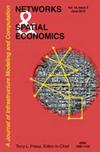检验区域经济增长的替代模型:可能性的边界(评A.G.伊萨耶夫《俄罗斯地区经济增长:外生和内生来源》一书)
IF 1.5
3区 工程技术
Q3 OPERATIONS RESEARCH & MANAGEMENT SCIENCE
引用次数: 2
摘要
在这项工作中,我们分析了A.G. Isaev在“俄罗斯地区经济增长:外生和内生来源”中提出的俄罗斯区域经济增长因素研究的主要结果。重点介绍了本研究的工具基础的特点。A.G.伊萨耶夫试图测试不同程度地适应于解释区域增长现象的任务的替代宏观经济模型,这不可避免地提出了关于基于这种测试获得综合知识的可能性的问题。我们讨论了两个问题,使用条件收敛评估结果的例子,验证Verdoorn定律,并确定在区域经济中产生内生冲动的潜力,在书中提出。第一个不等式问题是所有经济动力学研究的共同问题,无论研究对象是什么,无论是国家的经济还是地区的经济。第二个问题是确定空间依赖性的来源和考虑它们的备选办法,这是研究区域经济增长所特有的问题。总的结论是,根据新古典主义和凯恩斯主义的经济增长模型得出有意义的、内部一致的结论,这一任务并非微不足道;考虑中的模型的均衡性问题是虚构的,因为它们对条件收敛的估计至少在定性层面上是一致的,它们不能告诉我们关于地区间收入不平等趋势的任何具体情况;新古典模型的使用仍处于区域经济动态研究的前沿,其中包括考虑空间依赖性方法的选择问题,解决这一问题需要将研究工作从特定因果关系的发现转向普遍模式的分析;不受欢迎但同时在描述区域间影响渠道的方式上是透明的模型,可用于研究该区域经济中产生和吸收冲动的机制本文章由计算机程序翻译,如有差异,请以英文原文为准。
Testing Alternative Models of Regional Economic Growth: The Boundaries of the Possible (On the Book by A.G. Isaev ‘Economic Growth of Russian Regions: Exogenous and Endogenous Sources’)
In this work we analyse the main results on the study of the factors of the regional economic growth in Russia that are presented in ‘Economic Growth of Russian Regions: exogenous and endogenous Sources’ by A.G. Isaev. The emphasis is made on the features of the instrumental base of the study. A.G. Isaev makes an attempt to test alternative macroeconomic models, adapted to varying degree to the tasks of interpreting the phenomena of regional growth, which inevitably raises questions about the possibilities of gaining synthetic knowledge based on such testing. We discuss two problems using the example of the results of conditional convergence assessment, verification of Verdoorn’s law, and determination of the potential for generating endogenous impulses in regional economies, presented in the book. The first problem of equifinality is common to all studies of economic dynamics, regardless of the objects that are considered in them, whether it is the economies of countries or regions. The second problem of determining the sources of spatial dependence and options for taking them into account is specific for studies of regional economic growth. The general conclusions are that the task of obtaining meaningful, internally consistent conclusions based on neoclassical and Keynesian models of economic growth is not trivial; the problem of equifinality for the models under consideration is imaginary, since their estimates of conditional convergence coincide at least on a qualitative level and they cannot tells us anything specific about the trends of interregional income inequality; there are issues arising from the use of neoclassical models that are still at the forefront of research on regional economic dynamics, including the issues related to the choice of the method of taking into account spatial dependence, the solution of which requires a certain reorientation of research work from the detection of particular causal effects to the analysis of universal patterns; models that are unpopular but at the same time transparent in the way they describe the channels of interregional influences can be useful in studies of the mechanisms of generation and absorption of impulses in the economy of the region
求助全文
通过发布文献求助,成功后即可免费获取论文全文。
去求助
来源期刊

Networks & Spatial Economics
社会科学-运筹学与管理科学
CiteScore
4.00
自引率
4.20%
发文量
26
审稿时长
>12 weeks
期刊介绍:
Networks and Spatial Economics (NETS) is devoted to the mathematical and numerical study of economic activities facilitated by human infrastructure, broadly defined to include technologies pertinent to information, telecommunications, the Internet, transportation, energy storage and transmission, and water resources. Because the spatial organization of infrastructure most generally takes the form of networks, the journal encourages submissions that employ a network perspective. However, non-network continuum models are also recognized as an important tradition that has provided great insight into spatial economic phenomena; consequently, the journal welcomes with equal enthusiasm submissions based on continuum models.
The journal welcomes the full spectrum of high quality work in networks and spatial economics including theoretical studies, case studies and algorithmic investigations, as well as manuscripts that combine these aspects. Although not devoted exclusively to theoretical studies, the journal is "theory-friendly". That is, well thought out theoretical analyses of important network and spatial economic problems will be considered without bias even if they do not include case studies or numerical examples.
 求助内容:
求助内容: 应助结果提醒方式:
应助结果提醒方式:


